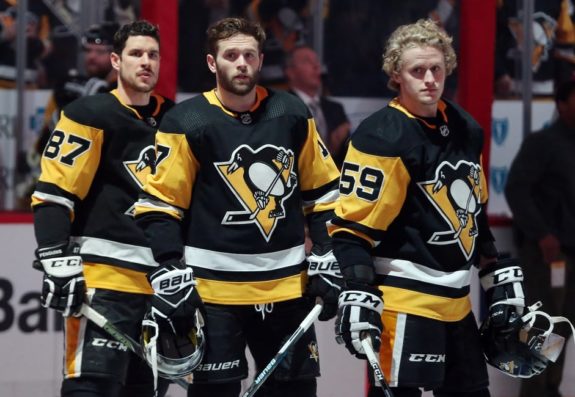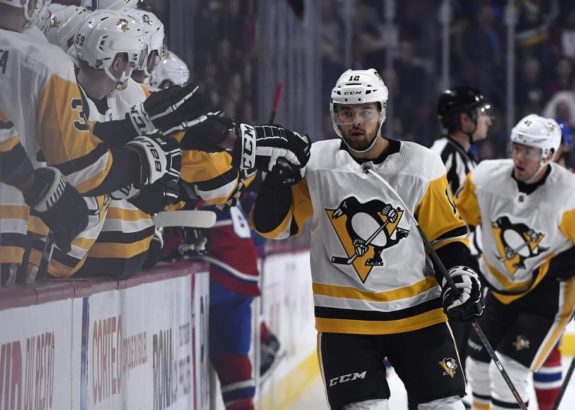There is no denying that the Pittsburgh Penguins’ offense is better than their defense. As it stands, they have two generational centers who will be sure-fire Hall of Famers when their careers are over. They also have a mix of youth and veterans who can fill the gaps as needed. Scoring is rarely an issue for the Penguins but can they carry the load and lead the Pens to another Cup run? Here are the projected forward lines for 2019-20.
First Line: Jake Guentzel- Sidney Crosby- Bryan Rust
Let’s start with arguably the best player in the league and a future first ballot Hall of Famer, Sidney Crosby. The Penguins captain has been leading the team since he was drafted first overall in the 2005 NHL Entry Draft. He has 1216 regular-season points and an additional 186 playoff points. He is a three-time Stanley Cup Champion, two-time Conn Smythe Trophy (Playoff MVP) winner, and seven-time All Star.
In the 2018-19 season, Crosby led the team in points with 100 and head coach Mike Sullivan called the 32-year-old the best 200-foot player in the game. Crosby will anchor the team in all three zones as well as on the power play (PP). Look for Sid the Kid to play at least 20 minutes a night as well as earn at least a point per game.
On Crosby’s left is Jake Guentzel, a spot he has occupied since he entered the league in the 2016-17 season. Guentzel immediately put himself on the map by scoring a goal on each of his first two shots in his NHL debut. In the 2017 Stanley Cup Playoffs, he scored 13 goals to lead playoffs. Last season, he scored 40 goals, most while on the same line as Crosby. His 33 even-strength goals were tied for third in the NHL, trailing only John Tavares and Patrick Kane.
Sullivan has rarely tinkered with their connection, one of the best in the NHL. The Penguins rewarded Guentzel with a five-year, $30-million contact to lock up their top winger long term. He is expected to be on the top power play unit after the departure of Phil Kessel. Playing next to Crosby should provide Guentzel the opportunity to be among the league leaders in goals.

Bryan Rust should be the right winger on this line. An integral part of both Stanley Cup teams, Rust scored big goals when the team needed them most. Consistency was the biggest issue for Rust last season. When he played with Crosby and Guentzel, his stats were significantly better than when he was on a different line. Rust is one of the top penalty-killers, which is valued by the coaching staff. Sullivan should stick with this trio and let the goals pour in. Look for this line to be the catalyst for the team’s season.
Second Line: Zach Aston-Reese- Evgeni Malkin- Alex Galchenyuk
The 2009 Conn Smythe Trophy winner Evgeni Malkin leads the second line. The 32-year-old Russian was the second-overall pick in the 2004 Entry Draft and has been a key cog for the Penguins since then. With 1170 career points, the Hall of Fame awaits Malkin when he decides to hang up his skates. He is expected to rebound from a down season in 2018-19 when he only scored 72 points and was a minus-25. He also led the team in penalty minutes with 89. He will be on the point during the power play and his hard slap shot will strike fear into every opposing goalie.

On Malkin’s left is Zach Aston-Reese. While it may be a surprise to see
Aston-Reese on the second line, he was fifth last season in points scored per 60 minutes, trailing only Crosby, Malkin, Kessel, and Guentzel. He bounced between the second and fourth line all season when healthy. Injuries have hindered him from getting consistent playing time throughout his career. He put up his best offensive numbers last season next to Malkin and the same is expected in 2019-20. He is also one of the best penalty-killers and seeing him paired with Rust will not be a surprise.
The recently acquired Alex Galchenyuk will be on the right side of the second line, taking Kessel’s. This trade was partially done for to clear cap space but it doesn’t hurt the Penguins in production. In the last five seasons, Galchenyuk has had at least 40 points and he has experience on the PP. It will be interesting to see how effective he can be next to Malkin. His numbers are expected to go up when paired with someone as talented as Malkin. This is also the last year of Galchenyuk’s current deal, so a big showing could turn into a nice payday for him. The Penguins will hope he can get close to the 82 points that Kessel put up last season.
Third Line: Jared McCann- Nick Bjugstad- Patric Hornqvist
Leading the third line is Nick Bjugstad, who was acquired just before the trade deadline last season from the Florida Panthers. The Minnesota-native quickly became a fan favorite and was the definition of consistency on the third line. In his 32 games with the Penguins, he only had 14 points but part of that was due to his ice time being limited moving from a top-six role with the Panthers to a bottom-six role in Pittsburgh.

With a full offseason to get adjusted to the team, a 30-40 point season is expected of Bjugstad. He has eclipsed the 40-point total twice in his career, as recently as the 2017-18 season. At only 26 years old and two with more years on his contract, he is set to be the third line center the Penguins have been trying to find since Nick Bonino left after the 2016-17 season. Look for Bjugstad center the second power-play unit as well.
On the left is Jared McCann, who was acquired in the same trade as Bjugstad. McCann bounced around the top three lines last season but it was the best of his young career with 79 games played, 19 goals and 35 points, all career highs. His 11 goals and 7 assists in 32 games with the Penguins after his trade from Florida was slightly unexpected from the 23-year-old.
McCann had a lot of success with Crosby but, like Guentzel, he prefers the left side which puts him on the third line. When the Penguins decide to tinker with their lines, McCann could move up to the top line with Guentzel sliding over to the right wing. In this third line role, as well as time on the PK unit, McCann should play 13-15 minutes a night with the possibility for more if opportunity allows. Staying healthy will be key for him to consistently get more and more minutes.
The 2018-19 season could be categorized as a disappointment for Patric Hornqvist. With 37 points in 69 games, his production was not what the Penguins wanted from a player making $5.3 million a season. From Jan. 6-Mar. 1, he scored just one goal, without missing a game during that period. His lack of production after suffering two concussions is extremely alarming. Hornqvist must be better in the 2019-20 season. He is expected to be that net-front presence, especially on the top PP unit. A bounce back season for Hornqvist would be a delight for fans.
Fourth Line: Brandon Tanev- Teddy Blueger- Dominik Kahun/Dominik Simon
The Latvian born Teddy Blueger looks to be the fourth line center after a breakout 2018-19 season in his limited role. With 10 points in 28 games at the NHL level and 39 points in 45 games for the Wilkes Barre/Scranton Penguins of the AHL, big things are expected of the fan favorite in his first full NHL season. Blueger also filled in for Malkin on the second line late in the season when Malkin was injured, proving that he was ready for the NHL. A good penalty-killer will keep Blueger on the ice more than just your average bottom-six forward. With his new two-year contract at a team-friendly $750,000 per season, he will want to prove he belongs in the NHL.

The most controversial forward is Brandon Tanev. Tanev signed a six-year, $21-million contract this offseason after spending his entire career with the Winnipeg Jets. The length of the contract and the $3.5 million average annual value has Pens fans scratching their heads. A depth forward does not fill a position of need for the team when there are still questions marks about their defense. Last season was his best to date, but 29 points doesn’t warrant $3.5 million per season. General manager Jim Rutherford likes his low number of turnovers and he can play heavy minutes on the PK but Tanev will have to win over the fans quickly. Scoring a few goals early in the season will go a long way.
The final forward spot is up for grabs between the two Dominiks. First, the newly acquired Dominik Kahun from the Chicago Blackhawks joins the Penguins in a trade for Olli Maatta. The 2018-19 season was his first at the NHL level and he played all 82 games. Though he averaged just over 14 minutes a game, he still managed to score 37 points. Kahun should fit nicely onto the fourth line with the ability to move up should minutes open up. He has proven he can score with limited ice time and will be a key role-player.

The other Dominik is Dominik Simon, a fifth-round draft pick by the Penguins in 2015. Simon has been in the NHL since the midway point of the 2017-18 season, with the exception of five games in the two seasons prior. Last season started with promise but he fell flat. He was expected to join Guentzel and Crosby on the top line but he did not produce and was eventually shuffled throughout the bottom-six. He was a healthy scratch for a game or two as Sullivan looked for something to spark his game. Ultimately, his 28 points in 71 games needs to improve if he wants to see more than 13 minutes per game.
It remains to be seen which forward will be the “healthy scratch” this season. Simon, Kahun, Blueger, and Aston-Reese are the four most likely forwards who could be scratched if the offensive core is healthy. Sullivan will have a tricky time getting these players ice time and keeping everyone happy. It would make sense at this point for one of the Dominiks to be that player.
The Penguins seem fairly set on McCann as a winger unless injuries require a switch, keeping Blueger’s spot as the fourth line center safe. Aston-Reese also feels relatively safe considering his success last season. It seems like Simon will be the healthy scratch on opening night but your guess on which Dominik will be scratched is as good as mine.
Is a Cup Run Possible With These Forwards?
Any team that has Crosby, Malkin and Guentzel can make a Stanley Cup run. If Hornqvist can get back to his previous form before his concussions, and Bjugstad can fill that third-line center role as expected, and if Galchenyuk can produce similar numbers to Kessel, the Penguins will have a good chance to make a good playoff run. Health will also be important as injury issues are prevalent with this group. Hornqvist and Tanev need to justify their price tag and prove they belong in Pittsburgh. The Penguins are trying to capitalize on the Crosby-Malkin-Letang window and anything less than a Stanley Cup at the end of the season will be considered a failure.